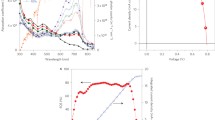Abstract
Recent work on solar cells based on interpenetrating polymer networks1,2,3 and solid-state dye-sensitized devices4 shows that efficient solar-energy conversion is possible using organic materials. Further, it has been demonstrated that the performance of photovoltaic devices based on small molecules can be effectively enhanced by doping the organic material with electron-accepting molecules5. But as inorganic solar cells show much higher efficiencies, well above 15 per cent, the practical utility of organic-based cells will require their fabrication by lower-cost techniques, ideally on flexible substrates. Here we demonstrate efficiency enhancement by molecular doping in Schottky-type photovoltaic diodes based on pentacene—an organic semiconductor that has received much attention as a promising material for organic thin-film transistors6,7,8, but relatively little attention for use in photovoltaic devices9,10. The incorporation of the dopant improves the internal quantum efficiency by more than five orders of magnitude and yields an external energy conversion efficiency as high as 2.4 per cent for a standard solar spectrum. Thin-film devices based on doped pentacene therefore appear promising for the production of efficient ‘plastic’ solar cells.




Similar content being viewed by others
References
Halls, J. J. M. et al. Efficient photodiodes from interpenetrating polymer networks. Nature 376, 498–500 (1995).
Yu, G., Gao, J., Hummelen, J. C., Wudl, F. & Heeger, A. J. Polymer photovoltaic cells: Enhanced efficiencies via a network of internal donor-acceptor heterojunctions. Science 270, 1789–1791 (1995).
Granström, M. et al. Laminated fabrication of polymeric photovoltaic diodes. Nature 395, 257–260 (1998).
Bach, U. et al. Solid-state dye-sensitized mesoporous TiO2 solar cells with high photon-to-electron conversion efficiencies. Nature 395, 583–585 (1998).
Chamberlain, G. A., Cooney, P. J. & Dennison, S. Photovoltaic properties of merocyanine solid-state photocells. Nature 289, 45–47 (1981).
Lin, Y.-Y., Gundlach, D. J., Nelson, S. F. & Jackson, T. N. Pentacene-based organic thin-film transistors. IEEE Trans. Electr. Dev. 44, 1325–1331 (1997).
Nelson, S. F., Lin, Y.-Y., Gundlach, D. J. & Jackson, T. N. Temperature-independent transport in high-mobility pentacene transistors. Appl. Phys. Lett. 72, 1854–1856 (1998).
Dimitrakopoulos, C. D., Purushothaman, S., Kymissis, J., Callegari, A. & Shaw, J. M. Low voltage organic transistors on plastic comprising high dielectric constant gate insulators. Science 283, 822–824 (1999).
Signerski, R., Jarosz, G. & Godlewski, J. Photoelectric properties of heterojunctions formed from di-(pyridyl)-perylenetetracarboxylic diimide and copper phtalocyanine or pentacene. Synth. Met. 94, 135–137 (1998).
Videlot, C., Fichou, D. & Garnier, F. Photovoltaic cells based on organic semiconductors. J. Chim. Phys. 95, 1335–1338 (1998).
Laudise, R. A., Kloc, Ch., Simpkins, P. G. & Siegrist, T. Physical vapor growth of organic semiconductors. J. Cryst. Growth 187, 449–454 (1998).
Minikata, T, Imai, H., Ozaki, M. & Saco, K. Structural studies on highly ordered and highly conductive thin films of pentacene. J. Appl. Phys. 72, 5220–5225 (1992).
Schön, J. H., Kloc, Ch., Laudise, R. A. & Batlogg, B. Electrical properties of single crystals of rigid rodlike conjugate molecules. Phys. Rev. B 58, 12952–12957 (1998).
Minakata, T., Nagoya, I. & Ozaki, M. Highly ordered and conducting thin films of pentacene doped with iodine vapor. J. Appl. Phys. 69, 7354–7356 (1991).
Hovel, H. J. Semiconductors and Semimetals Vol. 11, Solar Cells 71–92 (Academic, New York, 1975).
Karl, N. in Semiconductors (eds Madelung, O., Schulz, M. & Weiss, H.) Subvolume 17i, 106–218 (Landolt-Börnstein, New Series Vol. 17, Springer-Verlag, Berlin, 1985).
Chamberlain, G. A. Depletion layer studies and carrier photogeneration in doped merocyanine photovoltaic cells. J. Appl. Phys. 53, 6262–6269 (1982).
Videlot, C. & Fichou, D. Influence of molecular orientation on the photovoltaic properties of octithiophene. Synth. Met. 102, 885–888 (1999).
Tang, C. W. Two-layer organic photovoltaic cell. Appl. Phys. Lett. 48, 183–185 (1986).
Wöhrle, D. et al. Investigations of n/p junction photovoltaic cells of perylenetetracarboxylic acid diimides and phthalocyanines. J. Mater. Chem. 5, 1819–1829 (1995).
Wöhrle, D. & Meissner, D. Organic solar cells. Adv. Mater. 3, 129–138 (1991).
Acknowledgements
We thank E. Chandross, Z. Bao, H. Katz and A. Dodabalapur for helpful discussions. J.H.S. gratefully acknowledges financial support by the ‘Deutsche Forschungsgemeinschaft’.
Author information
Authors and Affiliations
Corresponding author
Rights and permissions
About this article
Cite this article
Schön, J., Kloc, C., Bucher, E. et al. Efficient organic photovoltaic diodes based on doped pentacene. Nature 403, 408–410 (2000). https://doi.org/10.1038/35000172
Received:
Accepted:
Issue Date:
DOI: https://doi.org/10.1038/35000172
- Springer Nature Limited
This article is cited by
-
Carrier transport mechanisms and photovoltaic characteristics of Au/toluidine blue/n-Si/Al heterojunction solar cell
Journal of Materials Science: Materials in Electronics (2018)
-
Dark electrical properties and photovoltaic performance of organic/inorganic (SnPcCl2/p-Si) solar cells
Journal of Materials Science: Materials in Electronics (2016)
-
Charge separation and ultraviolet photovoltaic conversion of ZnO quantum dots conjugated with graphene nanoshells
Nano Research (2012)
-
Organic optocouplers
Science China Chemistry (2011)
-
Mobility–diffusivity relationship for heavily doped organic semiconductors
Applied Physics A (2008)





